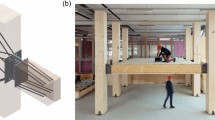Abstract
Bolted joint structures are prone to bolt loosening under environmental and operational vibrations, which may severely affect the structural integrity. This paper presents a bolt looseness recognition method based on the subharmonic resonance analysis. The bolted joint structure was simplified to a two-degree-of-freedom nonlinear model, and a multiple timescale method was used to explain the phenomenon of the subharmonic resonance and conditions for the generation of subharmonics. Numerical simulation predictions for the generation of the subharmonics and conditions for the subharmonics can be found with respect to the excitation frequency and the excitation amplitude. Experiments were performed on a bolt-joint aluminum beam, where the damage was simulated by loosening the bolts. Two surface-bonded piezoelectric transducers were utilized to generate continuous sinusoidal excitation and to receive corresponding sensing signals. The experimental results demonstrated that subharmonic components would appear in the response spectrum when the bolted structure was subjected to the excitation of twice its natural frequency. This subharmonic resonance method was found to be effective on bolt looseness detection.








Similar content being viewed by others
References
Mínguez, J.M., Vogwell, J.: Effect of torque tightening on the fatigue strength of bolted joints. Eng. Fail. Anal. 13(8), 1410–1421 (2006)
Meo, M., Zumpano, G.: Nonlinear elastic wave spectroscopy identification of impact damage on a sandwich plate. Compos. Struct. 71, 469–474 (2005)
Solodov, I., Pfleiderer, K., Busse, G.: Nonlinear Acoustic NDE: Inherent Potential of Complete Nonclassical Spectra. In: Universality of Nonclassical Nonlinearity, pp. 467–486 (2006)
Coelho, C.K., Das, S., Chattopadhyay, A., et al.: Detection of fatigue cracks and torque loss in bolted joints. In: Proceedings of Spie, 6532 (2007)
Liang Y., Zhang Y. C., Ding K. Q., et al.: Monitoring and Localization of Loosened Bolts Based on E/M Impedance Method. Sci. Technol. Eng. 13(18), 1671–1815 (2013)
Argatov, I., Sevostianov, I.: Health monitoring of bolted joints via electrical conductivity measurements. Int. J. Eng. Sci. 48(10), 874–887 (2010)
Jalali, H., Ahmadian, H., Mottershead, J.E.: Identification of nonlinear bolted lap-joint parameters by force-state mapping. Int. J. Solids Struct. 44(25–26), 8087–8105 (2007)
Eriten, Melih, Kurt, Mehmet, Luo, Guanyang, et al.: Nonlinear system identification of frictional effects in a beam with a bolted joint connection. Mech. Syst. Signal Process. 39(1–2), 245–264 (2013)
Amerini, F., Meo, M.: Structural health monitoring of bolted joints using linear and nonlinear acoustic/ultrasound methods. Struct. Health Monit. 10(6), 659–672 (2011)
Fierro, G.P.M., Meo, M.: Residual fatigue life estimation using a nonlinear ultrasound modulation method. Smart Mater. Struct. 24(2), 025040-238 (2015)
Jaques J., Adams D.: Using Impact Modulation to Identify Loose Bolts on a Satellite (2011)
Liu, S., Croxford, A.J., Neild, S., et al.: Effects of experimental variables on the nonlinear harmonic generation technique. IEEE Trans. Ultrason. Ferroelectr. Freq. Control 58(7), 1442–1451 (2011)
Ohara, Y., Yamamoto, S., Mihara, T., et al.: Ultrasonic evaluation of closed cracks using subharmonic phased array. Jpn. J. Appl. Phys. 47, 3908 (2008)
Johnson, D.R., Wang, K.W., Kim, J.S.: Investigation of the threshold behavior of subharmonics for damage detection of a structure with a breathing crack. In: SPIE Smart Structures and Materials+ Nondestructive Evaluation and Health Monitoring. International Society for Optics and Photonics, pp. 765032-9 (2010)
Mahmoodi, S.N., Jalili, N., Ahmadian, M.: Subharmonics analysis of nonlinear flexural vibrations of piezoelectrically actuated microcantilevers. Nonlinear Dyn. 59(3), 397–409 (2010)
Bograd, S., Reuss, P., Schmidt, A., et al.: Modeling the dynamics of mechanical joints. Mech. Syst. Signal Process. 25(8), 2801–2826 (2011)
Meyer, J.J., Adams, D.E.: Theoretical and experimental evidence for using impact modulation to assess bolted joints. Nonlinear Dyn. 81(1–2), 103–117 (2015)
Nayfeh, A.H., Mook, D.T.: Nonlinear Oscillations. Wiley, New York (1979)
Acknowledgements
Support from National Natural Science Foundation of China #51378402 and #51605284 is thankfully acknowledged.
Author information
Authors and Affiliations
Corresponding author
Rights and permissions
About this article
Cite this article
Zhang, M., Shen, Y., Xiao, L. et al. Application of subharmonic resonance for the detection of bolted joint looseness. Nonlinear Dyn 88, 1643–1653 (2017). https://doi.org/10.1007/s11071-017-3336-1
Received:
Accepted:
Published:
Issue Date:
DOI: https://doi.org/10.1007/s11071-017-3336-1




